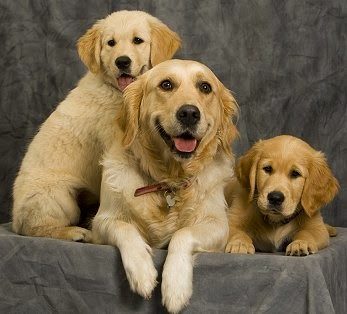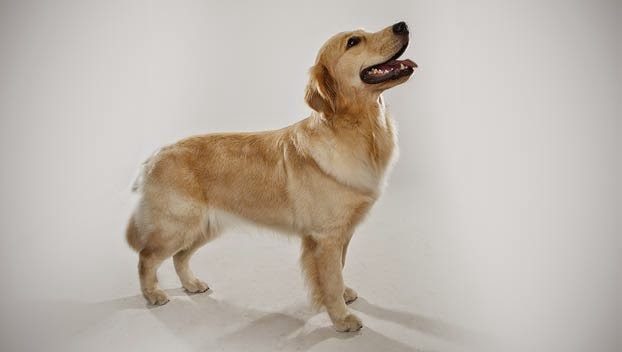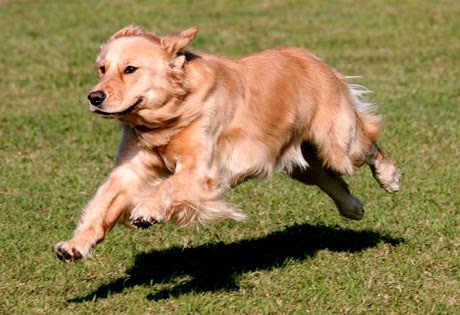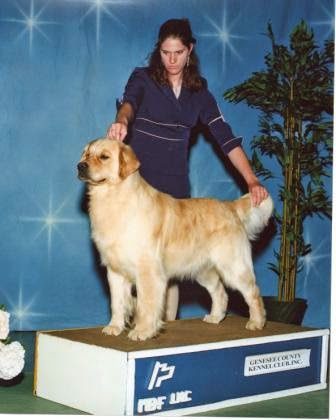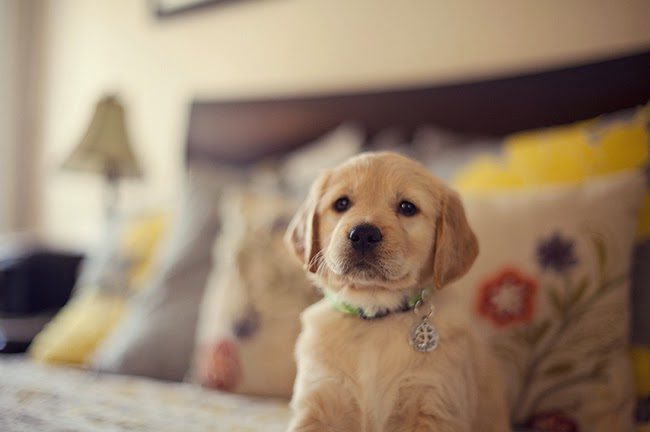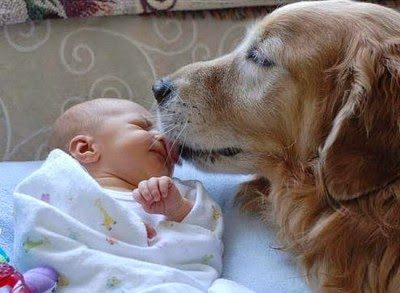- The Golden has a dense, water-repellent double coat that comes in various shades of gold. Goldens shed heavily and require frequent brushing to keep the fur from flying.
- Goldens typically have litters of six to eight puppies. Most breeders like to keep puppies until they are at least eight weeks old. This gives the puppies time to learn how to behave toward other dogs and gives the breeder time to evaluate the puppies’ personalities so she can place each one in just the right home. A bonus is that puppies of this age are more mature and more easily housetrained.
UKC group: Gun Dog
Average lifespan: 10-12 years
Average size: 55-75 pounds
Coat appearance: Long, dense, firm
Coloration: Any shade of golden
Hypoallergenic: No
Other identifiers: Luxurious golden coat, sturdy and well-balanced body frame.
Possible alterations: Cream or red coloration not accepted by AKC.
History
The Golden is one of the breeds created during the dog-loving Victorian era. The breeds in his background probably included a yellow retriever, the Tweed Water Spaniel, wavy- and flag-coated retrievers and a red setter.
Dudley Marjoribanks, Lord Tweedmouth, is generally credited with producing the first dogs that were to become known as Golden Retrievers, but recent research into studbooks, old paintings and other sources suggests that dogs similar to the Golden Retriever, possibly a type of setter, existed before Lord Tweedmouth began breeding them at his Scottish estate, Guisachan. England’s Kennel Club classified the dogs as “Retriever — Yellow or Golden” in 1911, then changed the name to “Retriever — Golden” in 1920.
Golden Retrievers were first registered with the American Kennel Club in 1925 and were officially recognized as a breed in 1932. Since then they have established themselves as versatile companions, hunting dogs and working dogs. Goldens are found doing search and rescue, animal-assisted therapy, arson detection, drug detection and assistance work for people with disabilities. Their energy, enthusiasm and intelligence make them well suited to learning and performing almost any task.
Today, Goldens are among the most beloved of breeds and rank fifth among the breeds registered by the AKC.
Temperament and Personality
Ask anyone about the defining characteristic of the Golden Retriever, and the answer you will always get is temperament. The hallmark of the Golden is his kind, gentle, eager-to-please nature. He craves affection and will seek it from strangers as well as his own family.
Goldens are adaptable and people-oriented, and those characteristics are at the top of the list of reasons people love them. Unfortunately, the breed’s popularity has meant that careless or clueless people have begun churning out Goldens without any attempt to maintain their sweet, gentle disposition. Shyness and aggression can be problems, leading to fear biting or unfriendliness toward people and other dogs.
Proper Goldens love everyone, but that love for people will often translate into jumping as a form of greeting. Basic, early obedience training is a must for these big, rambunctious dogs. Fortunately, Goldens are very easy to train, and a small investment of time when the dog is young will pay off when he’s full-grown. He will readily sit on command, walk on a leash without pulling and come when called.
If not trained, socialized and exercised daily, the good-natured exuberance of Goldens – especially as adolescents and young adults – can be overwhelming, and even frightening to small children, despite the dog’s best intentions to be friendly. Choose a Golden as a family dog only if you are prepared to supervise kids and dog when they are together and make sure everyone plays nicely. It’s normal for puppies to chase and bite in play, so you need to teach a Golden pup how to act around kids, as well as teach the kids how to play properly with the dog.
Any dog, even a Golden, can develop obnoxious levels of barking, digging, food stealing and other undesirable behaviors if he is bored, untrained or unsupervised. And any dog can be a trial to live with during adolescence. In the case of the Golden, the “teen” years can start at six months and continue until the dog is two or three years old. Start training early, be patient and be consistent, and one day you will wake up to find that you live with a great dog.
The perfect Golden Retriever is a product of his environment and breeding. Whether you want a Golden as a companion, show dog, canine competition dog or all three in one, look for one whose parents have nice personalities and who has been well socialized from early puppyhood.
Health
The Golden Retriever has a lifespan of between 10 and 13 years. Some of its minor health problems include hypothyroidism, sub-aortic stenosis (SAS), eye disorders, elbow dysplasia, mast cell tumors, and seizures. Osteosarcoma is also occasionally seen in Golden Retrievers. Other major health concerns for the breed include lymphoma, canine hip dysplasia (CHD), hemangiosarcoma, and skin problems. To identify these conditions early, a veterinarian may recommend heart, hip, thyroid, eye, or elbow tests during routine checkups.
Living Conditions
This breed will do okay in an apartment if sufficiently exercised. They are moderately active indoors and will do best with at least a medium to large yard.
Exercise
The Golden Retriever needs to be taken on a daily, brisk, long walk, jog or run alongside you when you bicycle, where the dog is made to heel beside or behind the person holding the lead, as instinct tells a dog that the leader leads the way and that leader needs to be the human. In addition, they like to retrieve balls and other toys. Be sure to exercise this dog well to avoid hyperactivity.
Care
To encourage turnover over of the coat and minimize buildup of hair inside the house, it is best to routinely brush a Golden Retriever’s coat at least twice a week. And though it is capable of living outdoors, the Retriever is at its best when kept indoors with the family. In addition, it is important for the Retriever to maintain a daily exercise routine, or take part in active games, so that it can spend its natural energy and relax comfortably during “non-playing” hours.
Grooming
It takes some dedication to live with a Golden Retriever. The Golden’s profuse coat requires regular brushing and bathing to remove debris and mats. And while all dogs shed, Goldens do it with the same enthusiasm they bring to swimming and retrieving. You can keep it under control with daily brushing to remove the dead undercoat, but if shedding is a deal-breaker at your house, this is not the breed for you.
Like most retrievers, Goldens love water. When your Golden gets wet – and he will – give him a thorough freshwater rinse to remove chlorine, salt or lake muck from his fur, all of which can be drying or otherwise damaging to the coat. Keep his ears dry to prevent infections, and use an ear cleaner recommended by your veterinarian after he goes swimming.
The rest is basic care. Trim his nails as needed, usually every few weeks, and brush his teeth for good overall health and fresh breath.
Is this breed right for you?
Goldens can adapt to just about every lifestyle and environment; however, they’re best suited for families with children and large living spaces with room to roam. They can do well in small apartments if daily exercise is incorporated into their routine. Owners must dedicate time for regular grooming to prevent knots in their long golden coat. Goldens are eager to please their human counterparts and therefore excel at training since they love the bond it creates for their master-canine relationship. Families with young children are encouraged to enroll their Golden into basic obedience courses early on.
Children and other pets
The amiable Golden Retriever isn’t bothered by the noise and commotion of kids — in fact, he thrives on it. He’s a large, strong dog, though, and he can easily knock over a small child by mistake.
As with every breed, you should always teach children how to approach and touch dogs, and always supervise any interactions between dogs and young children to prevent any biting or ear or tail pulling on the part of either party. Teach your child never to approach any dog while he’s eating or sleeping or to try to take the dog’s food away. No dog, no matter how friendly, should ever be left unsupervised with a child.
The Golden’s attitude toward other pets is the more the merrier. He enjoys the companionship of other dogs, and with proper introductions and training, can be trusted with cats, rabbits, and other animals.
Notable dogs
Liberty, the presidential pet of President Gerald R. Ford,and Victory, the presidential pet of Ronald Reagan, were Golden Retrievers.
The breed has also featured in a number of films and TV series, including: Air Bud and Air Bud: Golden Receiver, Full House, Homeward Bound: The Incredible Journey and Homeward Bound II: Lost in San Francisco, Fluke, Napoleon, Up, Pushing Daisies, The Drew Carey Show, and Cats & Dogs. Cash from The Fox and the Hound 2 was also a mix of this breed, as was Whopper from Pound Puppies.
Did You Know?
During the Ford Administration, a Golden Retriever lived in the White House. Liberty, a gift to President Gerald Ford from his daughter Susan, spent her days keeping him company in the Oval Office and splashing in the pool at Camp David.
